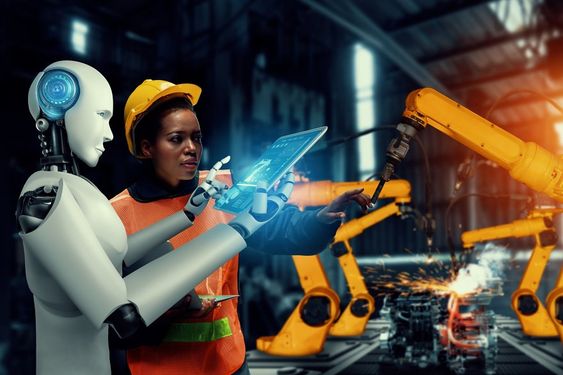In the realm of modern manufacturing, the dawn of Industry 4.0 signifies a revolutionary departure from traditional production methodologies. At the epicenter of this transformation stands the strategic integration of robotics within manufacturing facilities. This article delves into the profound significance of employing robotics in factories, elucidating its multifaceted impacts on efficiency, quality, safety, resource optimization, workforce dynamics, and global competitiveness.
Enhanced Efficiency and Productivity
The deployment of robotics engenders a paradigmatic enhancement in operational efficiency and productivity within manufacturing settings. Unfettered by the constraints of human limitations, robots operate tirelessly, ensuring seamless production continuity and minimizing downtime. Their unparalleled speed and precision revolutionize essential tasks such as assembly, welding, and packaging, accelerating production cycles and augmenting output volumes exponentially.

Elevated Quality Standards and Consistency
Robotic systems epitomize consistency and precision, heralding a new era of elevated quality standards in manufacturing. By meticulously adhering to programmed algorithms and leveraging advanced sensor technologies, robots execute tasks with unparalleled accuracy, virtually eliminating human error and variability. This unwavering consistency is indispensable in industries reliant on precision engineering, such as automotive and electronics manufacturing, ensuring uniform product quality and customer satisfaction.
Safety Reinforcement and Hazard Mitigation
Furthermore, the incorporation of robots in factory environments constitutes a pivotal stride towards bolstering workplace safety and mitigating occupational hazards. Proficient in handling hazardous materials, navigating perilous environments, and executing repetitive tasks prone to ergonomic risks, robots assume responsibilities that traditionally jeopardize human welfare. Consequently, their integration minimizes the incidence of workplace accidents and injuries, fostering a culture of safety and well-being among employees.
Resource Optimization and Sustainability
Robotic automation drives optimization across manufacturing operations, precipitating significant cost savings and resource efficiencies. By streamlining production processes and curbing material wastage, robots contribute to heightened operational efficiency and financial viability. Moreover, their programmable functionalities facilitate energy conservation initiatives and environmental stewardship, aligning with sustainability imperatives and regulatory mandates.
Empowerment of Human Potential
Contrary to misconceptions surrounding automation, the symbiotic relationship between humans and robots catalyzes the empowerment of human potential within manufacturing ecosystems. By delegating repetitive and physically strenuous tasks to robots, human workers are liberated to channel their cognitive faculties towards tasks demanding creativity, problem-solving, and strategic decision-making. This fusion of human ingenuity with robotic precision underscores a transformative synergy, optimizing productivity and augmenting workforce capabilities.

Catalyst for Innovation and Global Competitiveness
Strategic deployment of robotics in manufacturing not only fosters innovation but also amplifies organizational competitiveness on the global stage. Enterprises embracing robotic automation gain a formidable edge by expediting time-to-market, curbing production expenditures, and delivering superior-quality products at competitive price points. Furthermore, insights gleaned from robotics data analytics furnish invaluable intelligence for continuous process refinement and strategic decision formulation, fortifying organizations for sustained success amidst dynamic market landscapes.
In essence, the integration of robotics heralds an epochal advancement in manufacturing excellence, poised to redefine industry standards and narratives. By harnessing the transformative potential of robotics, enterprises can transcend conventional boundaries, propelling towards a future characterized by unparalleled efficiency, quality, safety, resource sustainability, workforce empowerment, and global competitiveness. As we navigate this transformative journey, embracing robotics emerges not merely as a choice but as an imperative requisite for unlocking the full spectrum of opportunities within the fabric of modern manufacturing.

